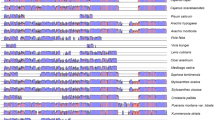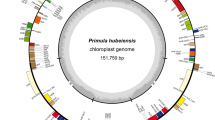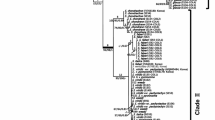Abstract
Pinus krempfii is morphologically very unique as compared to otherPinus species by having flat leaf-like needles. Its taxonomic position has been problematic ever since its discovery. In this study, an attempt was made to infer the taxonomic status ofP. krempfii through restriction fragment length polymorphism analysis of 12 PCR amplified chloroplast (cp) DNA regions. Phylogenetic analysis was conducted using 10 representatives of the twoPinus subgenera:Strobus andPinus. In addition, to infer the position ofP. krempfii in Pinaceae in relation with other genera, 14 representatives of eight additional genera were included in the analysis. Our cpDNA-based results indicate that: 1)P. krempfii clearly belongs to the genusPinus. This result does not favour the creation of a new genusDucampopinus in Pinaceae for this taxon. 2) Within the genusPinus, P. krempfii is more allied with species in subgenusStrobus and differs distinctly from species in subgenusPinus. 3) Despite the similarity in certain morphological and anatomical leaf and wood characters toKeteleeria andPseudolarix, the cpDNA data do not support the hypothesis for close relationship betweenP. krempfii and these two genera.
Similar content being viewed by others
References
Anonymus (1996a) Red Data Book of Vietnam. Vol. 2: Plants. Ministry of Science, Technology and Environment. Science and Technics Publishing House, Hanoi (in Vietnamese).
Anonymus (1996b) Vietnam Forest Trees. Forest Inventory and Planning Institute. Agricultural Publishing House, Hanoi.
Bremer K. (1988) The limits of amino acid sequence data in angiosperm phylogenetic reconstruction. Evolution 42: 795–803.
Bremer B. (1991) Restriction data chloroplast DNA for phylogenetic reconstruction: is there only one accurate way of scoring? Plant Syst. Evol. 175: 39–54.
Brunsfeld S. J., Soltis P. S., Soltis D. E., Gadek P. A., Quinn C. J., Strenge D. D., Ranker T. A. (1994) Phylogenetic relationships among the genera of Taxodiaceae and Cupressaceae: evidence fromrbcL sequences. Systematic Botany 19: 253–262.
Buchholz J. T. (1951) A flat-leaved pine from Annam, Indo-China. American Journal of Botany 38: 245–252.
Chase M. W. et al. (1993) Phylogenetics of seed plants: an analysis of nucleotide sequences from the plastid generbcL. Annals of the Missouri Botanical Garden 80: 528–580.
Chevalier A. (1944) Notes sur les conifères de l'Indochine. Revue de Botanique Appliquée et d'Agriculture Tropicale 24: 7–34.
Critchfield W. B., Little E. L. Jr. (1966) Geographic distribution of the pines of the world. USDA Forest Service Miscellaneous Publication 991.
De Ferré Y. (1948) Quelques particularités anatomiques d'un pin indochinois:Pinus Krempfii. Bulletin de la Société d'Histoire Naturelle de Toulouse 83: 1–6.
De Ferré Y. (1953) Division du genrePinus en quatre sous-genres. Academie des Sciences Compte Rendu 236: 226–228.
Donoghue M. J., Olmstead R. G., Smith J. F., Palmer J. D. (1992) Phylogenetic relationships of Dipsacales based onrbcL sequences. Annals of the Missouri Botanical Garden 79: 333–345.
Dowling T. E., Moritz C., Palmer J. D., Rieseberg L. H. (1996) Nucleic acids III: analysis of fragments and restriction sites. In: Hillis D. M., Moritz C., Mable B. K. (eds.) Molecular Syatematics, 2 edn. Sunderland, Sinauer Associates, pp. 249–320.
Eckenwalder J. E. (1976) Re-evaluation of Cupressaceae and Taxodiaceae: a proposed merger. Madroño 23: 237–256.
Erdtman H., Kimland B., Norin T. (1966) Wood constituents ofDucampopinus krempfii (Lecomte) Chevalier (Pinus Krempfii Lecomte). Phytochemistry 5: 927–931.
Farjon A. (1984) Pines. Drawings and descriptions of the genusPinus. E. J. Brill/DR. W. Backhuys, Leiden.
Farjon A. (1990) Pinaceae. Drawings and descriptions of the generaAbies, Cedrus, Pseudolarix, Keteleeria, Nothotsuga, Tsuga, Cathay, Pseudotsuga, Larix andPicea. Regnum Vegetabile 121. Koeltz Scientific Books, Königstein.
Farjon A. (1996) Biodiversity ofPinus (Pinaceae) in Mexico: speciation and palaeo-endemism. Botanical Journal of the Linnean Society 121: 365–384.
Farjon A., Styles B. T. (1997)Pinus (Pinaceae). Flora Neotropica Monograph 75. The New York Botanical Garden, New York.
Farris J. S. (1989) The retention index and the rescaled consistency index. Cladistics 5: 417–419.
Felsenstein J. (1985) Confidence limits on phylogenies: an approach using the bootstrap. Evolution 39: 783–791.
Florin R. (1931) Untersuchungen zur Stammesgeschichte der Coniferales und Cordaitales. Erster Teil: Morphologie und Epidermisstruktur der Assimilationsorgane bei den rezenten Koniferen. Kungliga Svenska Vetenskapsakademiens Handlingar Ser. 3. 10: 1–588.
Frankis M. P. (1989) Generic inter-relationships in Pinaceae. Notes of the Royal Botanical Garden of Edinburgh 45: 527–548.
Frankis M. P. (1993) Morphology and affinities ofPinus brutia. In International Symposium onPinus brutia Ten., pp. 11–18. Ministry of Forestry, Ankara.
Gaussen H. (1960) Les gymnospermes actuelles et fossiles. Fassicule VI. Les Conifères. Chap. 11. Généralités, GenrePinus. Travaux du Laboratoire Forestier Toulouse. Tome 2, Sect. 1, Vol. 1, Chap. 11: 1–272.
Govindaraju D., Lewis P., Cullis C. (1992) Phylogenetic analysis of pines using ribosomal DNA restriction fragment length polymorphisms. Plant Syst. Evol. 179: 141–153.
Hart J. A. (1987) A cladistic analysis of conifers: preliminary results. Journal of the Arnold Arboretum 68: 269–307.
Ickert-Bond S. M. (1997)Pinus krempfii Lec. a Vietnamese conifer with problematic affinities. American Journal of Botany (Suppl.) 84: 203, Abstract 589.
Karalamangala R. R., Nickrent D. L. (1989) An electrophoretic study of representatives of subgenusDiploxylon ofPinus. Canadian Journal of Botany 67: 1750–1759.
Klaus W. (1989) Mediterranean pines and their history. In: Ehrendorfer F. (ed.) Woody Plants — Evolution and Distribution Since the Tertiary. Plant Syst. Evol. (Special Edition) 162: 133–163.
Kluge A. G., Farris J. S. (1969) Quantitative phyletics and the evolution ofAnurans. Systematic Zoology 18: 1–32.
Krupkin A. B., Liston A., Strauss S. H. (1996) Phylogenetic analysis of the hard pines (Pinus subgenusPinus, Pinaceae) from chloroplast DNA restriction site analysis. American Journal of Botany 83: 489–498.
Kwei Y. L., Lee C. L. (1963) Anatomical studies of the leaf structure of Chinese pines. Acta Botanica Sinica 11: 44–66 (in Chinese).
Lavin M., Mathews S., Hughes C. (1991) Chloroplast DNA variation inGliricidia sepium (Leguminosae): intraspecific phylogeny and tokogeny. American Journal of Botany 78: 1576–1585.
Lecomte H. (1921) Un pin remarquable de l'Annam. Bulletin du Museum National d'Histoire Naturelle Paris 27: 191–192.
Lecomte H. (1924) Additions au sujet dePinus krempfii H. Lec. Bulletin du Museum National d'Histoire Naturelle Paris 30: 321–325.
Liston A., Robinson W. A., Piñero D., Alvarez-Buylla E. R. (1999) Phylogenetics ofPinus (Pinaceae) based on unclear ribosomal DNA internal transcribed spacer region sequences. Molecular Phylogenetics and Evolution 11: 95–109.
Little E. L. Jr., Critchfield W. B. (1969) Subdivisions of the genusPinus (pines). USDA Forest Service Miscellaneous Publication 1144.
Millar C. I. (1993) Impact of the Eocene on the Evolution ofPinus. Annals of the Missouri Botanical Garden 80: 471–498.
Miller C. N. Jr. (1976) Early evolution in the Pinaceae. Review of Palaeobotany and Palynology 21: 101–117.
Miller C. N. Jr. (1977) Mesozoic conifers. The Botanical Review 43: 217–280.
Mirov N. T. (1967) The genusPinus. The Ronald Press Company, New York.
Moran G. F., Smith D., Bell J. C., Appels R. (1992) The 5S-RNA genes inPinus radiata and the spacer region as a probe for relationships betweenPinus species. Plant Syst. Evol. 183: 209–221.
Nguyên H. N. (1993) Two-flat-needle pine endemic to Vietnam. Forestry Review 32: 10–11 (in Vietnamese).
Nguyên T. H., Vidal J. E. (1996) Flore du Cambodge du Laos et du Viêtnam. Vol. 28: Gymnospermae. Muséum National d'Histoire Naturelle, Paris. (ISBN 2-85654-202-6).
Parducci L., Szmidt A. E. (1999) PCR-RFLP analysis of cpDNA in the genusAbies. Theoretical and Applied Genetics 98: 802–808.
Pérez De La Rosa J., Harris S. A., Farjon A. (1995) Noncoding chloroplast DNA variation in Mexican pines. Theoretical and Applied Genetics 91: 1101–1106.
Pilger R. (1926)Coniferae. In: Engler A., Prantl K. (eds.) Die Natürlichen Pflanzenfamilien. Vol. 13 (ed.2).Gymnospermae. Wilhelm Engelmann, Leipzig, pp. 121–403.
Piovesan G., Pelosi C., Schirone A., Schirone B. (1993) Taxonomic evaluations of the genusPinus (Pinaceae) based on electrophoretic data of salt soluble and insoluble seed storage proteins. Plant Syst. Evol. 186: 57–68.
Plunkett G. M., Soltis D. E., Soltis P. S. (1997) Clarification of the relationship between Apiaceae and Araliaceae based onmatK andrbcL sequence data. American Journal of Botany 84: 565–580.
Prager E. M., Fowler D. P., Wilson A. C. (1976) Rates of evolution in conifers (Pinaceae). Evolution 30: 637–649.
Price R. A. (1989) The genera of Pinaceae in the southeastern United States. Journal of the Arnold Arboretum 70: 247–305.
Price R. A., Olsen-Stojkovich J., Lowenstein J. M. (1987) Relationships among the genera of Pinaceae: an immunological comparison. Systematic Botany 12: 91–97.
Sandbrink J. M., Van Brederode J. (1991) Different approaches to analysis of restriction fragment patterns of chloroplast DNA and phylogenetic relationships inSilene sectionSiphonomorpha (Caryophyllaceae). Biochemical Systematics and Ecology 19: 559–567.
Shaw G. R. (1914) The genusPinus. Publication of the Arnold Arboretum 5. Riverside Press, Cambridge, MA.
Stefanović S., Jager M., Deutsch J., Broutin J., Masselot M. (1998) Phylogenetic relationships of conifers inferred from partial 28S rRNA gene sequences. American Journal of Botany 85: 688–697.
Strauss S. H., Doerksen A. H. (1990) Restriction fragment analysis of pine phylogeny. Evolution 44: 1081–1096.
Swofford D. L. (1993) PAUP: Phylogenetic analysis using parsimony, version 3.1.1. Computer program distributed by the Illinois Natural History Survey. Champaign, IL.
Szmidt A. E., Lidholm J., Hällgren J.-H. (1986) DNA extraction and preliminary characterization of chloroplast DNA fromPinus sylvestris andPinus contorta. In: Lindgren D. (ed.) Frans Kempe Symposium on Provenances and Forest Tree Breeding for High Latitudes. Swedish University of Agricultural Sciences. (ISBN 91-576-2813-0), pp. 269–280.
Szmidt A. E., Wang X.-R., Changtragoon S. (1996) Contrasting patterns of genetic diversity in two tropical pines:Pinus kesiya Royle ex Gordon andP. merkusii Jungh. et De Vriese. Theoretical and Applied Genetics 92: 436–441.
Taberlet P., Gielly L., Pautou G., Bouvet J. (1991) Universal primers for amplification of three noncoding regions of chloroplast DNA. Plant Molecular Biology 17: 1105–1109.
Tsumura Y., Yoshimura K., Tomaru N., Ohba K. (1995) Molecular phylogeny of conifers using RFLP analysis of PCR-amplified specific chloroplast genes. Theoretical and Applied Genetics 91: 1222–1236.
Van Der Burgh J. (1973) Hölzer der niederrheinischen Braunkohlenformation usw. Nebst einer systematisch-anatomischen Bearbeitung der GattungPinus L. Review of Palaeobotany and Palynology 15: 73–275.
Wakasugi T., Tsudzuki S. I., Shibata M., Sugiura M. (1994) A physical map and clone bank of the black pine (Pinus thunbergii) Chloroplast Genome. Plant Molecular Biology Reporter 12: 227–241.
Wang X.-R. (1992) Genetic diversity and evolution of EurasianPinus species. PhD Thesis, Swedish University of Agricultural Sciences, Faculty of Forestry, Department of Forest Genetics and Plant Physiology. (ISBN 91-576-4641-4).
Wang X.-R., Szmidt A. E. (1993) Chloroplast DNA-based phylogeny of AsianPinus species (Pinaceae). Plant Syst. Evol. 188: 197–211.
Wolfe A. D., Elisens W. J., Watson L. E., Depamphilis W. (1997) Using restriction-site variation of PCR-amplified cpDNA genes for phylogenetic analysis of Tribe Cheloneae (Scrophulariaceae). American Journal of Botany 84: 555–564.
Wolfe A. D., Liston A. (1997) Contribution of PCR-based methods to plant systematics. In: Soltis D. E., Soltis P. S., Doyle J. J. (eds.) Molecular systematics of plants (ed. 2), chap. 2. Chapman and Hall, New York.
Author information
Authors and Affiliations
Rights and permissions
About this article
Cite this article
Wang, XR., Szmidt, A.E. & Nguyên, H.N. The phylogenetic position of the endemic flat-needle pinePinus krempfii (Pinaceae) from Vietnam, based on PCR-RFLP analysis of chloroplast DNA. Pl Syst Evol 220, 21–36 (2000). https://doi.org/10.1007/BF00985368
Received:
Accepted:
Issue Date:
DOI: https://doi.org/10.1007/BF00985368




